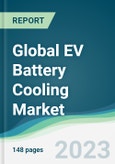The EV battery cooling market was valued at US$1,353.08 million in 2021.
Electric vehicle (EV) battery cooling is an important aspect of electric vehicle design and operation, as it is necessary to maintain a suitable temperature range for the battery cells to ensure optimal performance, longevity, and safety. The three main types of EV battery cooling systems for lead-acid and lithium-ion batteries include air cooling, liquid cooling, and fan cooling. EV battery cooling is used in different vehicle types, such as battery electric vehicles, hybrid electric vehicles, and plug-in hybrid electric vehicles. The growth of EV battery cooling systems will be due to the increasing demand for electric vehicles, rising concerns over battery safety and performance, and the need to comply with government emissions and fuel efficiency regulations.The increasing electric vehicle production will boost the growth of the global EV battery colling market.
Batteries generate heat during operation, and excessive heat can damage battery cells, reduce capacity, and shorten the battery's lifespan. Therefore, battery cooling systems are necessary to regulate the temperature and prevent overheating. EV battery cooling systems help prevent thermal runaways and reduce the risk of battery-related accidents, making electric vehicles safer. Colder batteries charge faster, while hotter batteries charge slower, and battery cooling systems help regulate the temperature and ensure consistent charging times. EV battery cooling is essential for maintaining optimal battery performance, safety, and reliability, making it a critical aspect of electric vehicle design and operation. Several countries' governments are implementing regulations on EV battery cooling to ensure the safety and performance of electric vehicles, promote their adoption, and reduce their environmental impact. The demand for EV battery cooling increases with the growing demand for electric vehicles, battery efficiency and safety, government regulations, and technological advancements. According to the International Council on Clean Transportation (ICCT), global electric vehicle production increased by 40% in 2022, reaching 8.2 million vehicles, with an increase of 2.3 million vehicles compared to 2021. According to the Korea Automobile Manufacturers Association (KAMA), in 2020, 11 incidents of electric vehicle battery fires took place in Korea. In 2021, the Chinese government introduced new safety standards for EVs that set battery safety and thermal management requirements to ensure the safety and reliability of EVs in China and promote the adoption of electric vehicles. This demonstrates that global EV battery cooling holds a great demand in the future.The Asia Pacific region is expected to constitute a dominant market share.
The Asia Pacific region is home to the world's largest and fastest-growing electric vehicle markets, including China, Japan, India, and South Korea, due to the demand for electric vehicles in the region, increasing urbanization, growing concerns about air pollution, and climate change. In 2021, the Chinese government launched the "New Energy Vehicle Industry Development Plan" to promote the growth of the electric vehicle market, which includes subsidies for electric vehicle purchases, tax incentives for electric vehicle manufacturers, investments in research and development of electric vehicle technologies, and development of charging infrastructure and battery cooling systems. In 2021, the Ministry of Road Transport and Highways of India mandated that electric vehicles must have a battery cooling system that meets certain standards to maintain the battery temperature within a certain range and be able to detect and respond to any temperature changes. In 2020, the Japanese government announced the "Green New Deal" initiative, which aims to achieve carbon neutrality by 2050, and the government plans to promote the adoption of electric vehicles and expand the charging infrastructure for EVs, which will further increase the demand for EV battery cooling. These factors all add to the EV battery cooling growth in Asia Pacific.Market Developments:
- October 2022:Using a brand-new, extremely high-performance dielectric fluid, TotalEnergies and Valeo announce signing a contract to create a novel method of cooling electric vehicle batteries.
- April 2022:Matter, an EV technology startup, launched India's first active liquid-cooled EV battery pack for electric bikes and scooters for the thermal management system.
- September 2021:BorgWarner announced a new liquid-cooled battery pack for electric vehicles, which has a high-efficiency cooling system that helps to maintain the battery's temperature and improve its overall performance.
Market Segmentation:
By Cooling Type
- Air Cooling
- Liquid Cooling
- Fan Cooling
By Battery Type
- Lead Acid
- Lithium Ion
- Others
By Vehicle Type
- Battery Electric Vehicles
- Hybrid Electric Vehicles
- Plug-In Hybrid Electric Vehicle
By Geography
- North America
- USA
- Canada
- Mexico
- South America
- Brazil
- Argentina
- Others
- Europe
- UK
- Germany
- France
- Spain
- Others
- Middle East and Africa
- Saudi Arabia
- UAE
- Others
- Asia Pacific
- China
- Japan
- India
- South Korea
- Australia
- Other
Table of Contents
1. INTRODUCTION
2. RESEARCH METHODOLOGY
3. EXECUTIVE SUMMARY
4. MARKET DYNAMICS
5. GLOBAL EV BATTERY COOLING MARKET BY COOLING TYPE
6. GLOBAL EV BATTERY COOLING BATTERY MARKET BY BATTERY TYPE
7. GLOBAL EV BATTERY COOLING MARKET BY VEHICLE TYPE
8. GLOBAL EV BATTERY COOLING MARKET BY GEOGRAPHY
9. COMPETITIVE ENVIRONMENT AND ANALYSIS
10. COMPANY PROFILES
Companies Mentioned
- 3M
- Boyd
- Hanon Systems
- MAHLE GmbH
- Modine Manufacturing Company
- Robert Bosch GmbH LLC
- Tata AutoComp System Ltd.
- Valeo
- Vikas Group
Methodology

LOADING...








